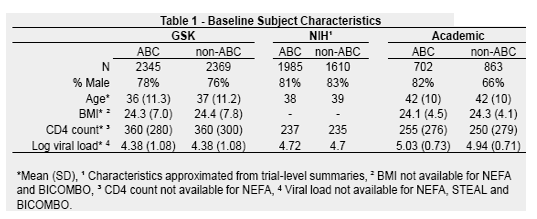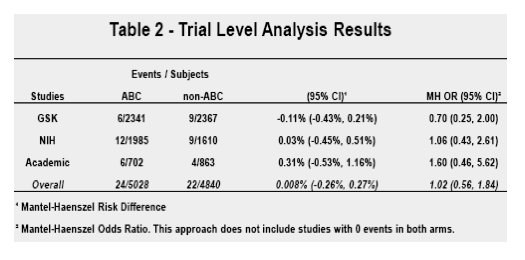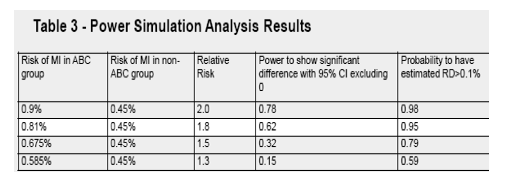 |
 |
 |
| |
No Association of Myocardial Infarction with Abacavir Use:
Findings of an FDA Meta-analysis
|
| |
| |
Reported by Jules Levin
CROI 2011 Boston March 2
Xiao Ding, Eugenio Andraca-Carrera, Charles Cooper, Peter Miele*, Cynthia Kornegay, Mat Soukup, and Kendall Marcus*
CDER/FDA
* Division Antiviral Products
Quantitative Safety Division (DB7)
Computational Science Center
Office of Surveillance and Epidemiology
Kendall Marcus, M.D.
Div. Antiviral Products/CDER/FDA
Kendall.marcus@fda.hhs.gov
301-796-0755
Conclusions
Recent observational studies have indicated a potential increase in risk of MI for patients with current or recent exposure to abacavir. Because residual confounding is not completely controllable in observational studies and can lead to false-positive results, we conducted a meta-analysis of prospective, controlled trials in which abacavir use was randomized and in which MI risk was moderate (0.45%). No statistically significant difference in MI events was detected between subjects receiving ABC-containing cART regimens and non-ABC cART regimens. Based upon our simulations, the power of our study to exclude a relative risk of 1.8 with the observed MI background risk (0.45%) was 0.62; however, lack of power does not explain the observed risk difference of 0.008% with a 95% CI of (-0.26%, 0.27%). The simulation to assess the power demonstrates that our study had a probability of 0.95 to find a risk difference of greater than 0.1%. Our study's finding is very unlikely if the true risk of ABC is 1.8 or higher at the observed background MI risk (0.45%). The results of our trial-level meta-analysis raise significant uncertainty about the likelihood of an ABC-MI risk association. To further understand the CV risk of abacavir in treated patients, a randomized, prospective study with primary CV outcomes would be needed.
ABSTRACT
Background: Abacavir (ABC) therapy has been associated with an increased risk of myocardial infarction (MI) in several observational studies and one randomized controlled trial (RCT). However, other RCTs and the aggregated safety database maintained by the drug manufacturer do not support this association. The U.S. Food and Drug Administration (FDA) conducted a trial-level meta-analysis of RCTs in which ABC use was randomized as part of a combined antiretroviral regimen (cART) to estimate the effect of ABC use on the risk of MI.
Methods: A literature search was conducted among 4 databases (International Pharmaceutical Abstracts [IPA], Intelos, Embase and Scopus) for all clinical trials that included a randomized ABC treatment arm. The FDA manually reviewed the results to identify RCTs that met the following criteria: conducted in adults, sample size greater than 50 subjects, status completed, not a pharmacokinetic trial, and not conducted in Africa. The Mantel-Haenzel method, with risk difference and 95% confidence interval, was used for the primary analysis based on trial-level summaries; unit of analysis was the subject and stratification factor was the trial. For trials with more than 2 arms, ABC versus non-ABC arms were compared.
Results: Data from 26 RCTs conducted from 1996 to 2010 were included in the analysis: 16 trials from the drug manufacturer database, 5 from the AIDS Clinical Trials Group (ACTG), and 5 from academic centers. A total of 9868 subjects were included in the analysis (5028 ABC, 4840 non-ABC) and 46 (0.47%) MI events were reported (24 [0.48%] ABC, 22 [0.46%] non-ABC). Mean follow-up was 1.43 person-years in the ABC group and 1.49 person-years in the non-ABC group. No significant difference was detected between the two groups in terms of developing MI (risk difference 0.008% with a 95% CI of (-.26%, 0.27%). A stratified odds ratio sensitivity analysis using 18 trials (8 trials with no MI events in either treatment group were excluded) similarly found no statistically significant association between MI and ABC use (OR, 1.02; 95% CI [0.56, 1.84]).
Conclusions: A meta-analysis conducted by the FDA based on RCTs did not show an association between increased risk of MI and use of ABC.
INTRODUCTION
Non-AIDS causes of death such as cardiovascular disease (CVD), liver disease and malignancy now account for the majority of deaths among HIV-infected persons receiving cART.i, ii While traditional CV risk factors play the same role in HIV-infected persons as in the general population, the risk of MI in HIV-infected persons on cART appears to be higher.iii,iv Both HIV infection itself and cART may contribute independently to this increased cardiovascular risk.v
In recent years, several observational studies and one randomized clinical trial have shown an association between current or recent (within 6 months) use of abacavir (ABC) and development of MI. For example, the D:A:D study, a large, prospective, observational study with an international cohort of 33,347 HIV-1-infected individuals, reported an increased risk of MI associated with current or recent ABC (relative risk [RR] 1.9, 95% confidence interval [CI]: 1.47 to 2.45, p = 0.0001).vi In another example, the Strategies for Management of Anti-Retroviral Therapy (SMART) study, a randomized clinical trial (RCT) evaluating treatment strategy, but not specific cART regimens, found an association between ABC and increased risk of CVD.vii Other analyses of data from randomized trials have not found an association.viii,ix
Given these conflicting results, the U.S. Food and Drug Administration (FDA) carried out a trial-level meta-analysis of RCTs in which ABC use was randomized as part of cART to estimate the effect of ABC use on risk of MI. To our knowledge, this represents the largest meta-analysis to date of clinical trials in which abacavir use was randomized.
Methods
A literature search was conducted among 4 databases (International Pharmaceutical Abstracts [IPA], Intelos, Embase and Scopus) for all clinical trials that included a randomized ABC treatment arm. The FDA manually reviewed the results to identify RCTs that met the following criteria: conducted in adults, sample size greater than 50 subjects, status completed, not a pharmacokinetic trial, and not conducted in Africa. The primary analysis method was the Mantel-Haenszel risk difference and the associated 95% confidence interval.x This method makes use of all 26 trials including trials with no MI events. The unit of analysis was the subject and the stratification factor was the trial. For trials with more than two arms, arms that were part of the same comparison group (ABC versus non-ABC) were combined. Confidence intervals for individual trials are based on exact methods.xi
RESULTS
Based upon the trial inclusion and exclusion criteria and data availability, a total of 26 RCTs were included in the trial-level meta-analysis. Of these 26 trials, 16 were conducted by GlaxoSmithKline (GSK), 5 by the National Institutes of Health (NIH), and 5 by academic centers. Within the 26 trials included in the analysis, 5028 subjects were randomized to ABC-containing cART regimens and 4840 subjects were randomized to non-ABC cART regimens. The mean follow-up period for the 26 trials was 719 person-years with a minimum of 42.2 person-years and a maximum of 1257.3 person-years. Accordingly, this results in an average duration of follow-up of 1.62 person-years for each subject with a minimum of 0.49 person-years per subject (COL30305) and a maximum of 4.72 person-years per subject (ACTG 372A). All events reported as acute MI or MI were included in this analysis. Events were reported by study investigators and were not adjudicated by FDA.
Baseline subject characteristics were not provided for all 26 trials. However, if available, this data was obtained from publications. Table 1 depicts the baseline subject characteristics.

Table 2 depicts a summary of overall results as well as a summary of the results based on the study sponsor (GSK, NIH, academic). Overall, no statistically significant difference in MI events was detected between subjects receiving ABC-containing cART regimens and non-ABC cART regimens: risk difference = 0.008% with a 95% CI of (-0.26%, 0.27%) and a corresponding odds ratio of 1.02 with 95% CI (0.56, 1.84). Separate analyses by the sponsor of the same trials (GSK, NIH, and academic) also did not show statistically significant difference in the risk of developing MI between the ABC-treated subjects and the non-ABC treated subjects. Figure 1 depicts a forest plot of the 26 trials sorted by average duration of follow-up per subject (shortest duration at the bottom to longest duration at the top). No trends regarding total amount of person-years of follow-up were seen in the meta-analysis. Further, no single trial showed a statistically significant increased risk of developing MI between subjects treated with ABC and subjects treated with non-ABC regimens.

Figure 1 - Forest Plot of Meta-Analysis Results: Trials sorted based on duration of person-years of follow-up
(shortest on bottom to longest on top)

Simulation
Using various assumptions for the risk of MI, additional exploratory simulations were conducted to evaluate the power that our meta-analysis would have to detect a significant difference and the probability that our analysis would show an estimated risk difference > 0.1%. This simulation was based on 100,000 replicates using the Mantel-Haenszel test of the risk difference; results are shown in Table 3.

References
i Mocroft A, Brettle R, Kirk O, et al. Changes in the cause of death among HIV positive subjects across Europe: results from the EuroSIDA study. AIDS. 2002;16:1663-1671.
ii Lewden C, Salmon D, Morlat P, et al. Causes of death among human immunodeficiency virus (HIV)-infected adults in the era of potent antiretroviral therapy: emerging role of hepatitis and cancers, persistent role of AIDS. Int J Epidemiol. 2005; 34:121-330.
iii Triant V, Lee H, Hadigan C, Grinspoon SK. Increased acute myocardial infarction rates and cardiovascular risk factors among patients with human immunodeficiency virus disease. J Clin Endocrinol Metab. 2007; 92:2506-2512.
iv Currier J, Taylor A, Boyd F, et al. Coronary Heart Disease in HIV-infected individuals. J Acquir Immune Defic Syndr. 2003; 33:506-512.
v Friis-Moller N, Weber R, Reiss P et al. Cardiovascular disease risk factors in HIV patients - association with antiretroviral therapy. Results from the DAD Study. AIDS 2003; 17: 1179-1193.
vi Sabin C, Worm S, Weber R et al. Use of nucleoside reverse transcriptase inhibitors and risk of myocardial infarction in HIV-infected patients enrolled in the DAD Study: a multi-cohort collaboration. Lancet 2008; 371: 1417-1426.
vii Strategies for management of antiretroviral therapy/INSIGHT: DAD study groups. Use of nucleoside reverse transcriptase inhibitors and risk of myocardial infarction in HIV-infected persons. AIDS 2008; 22:F17-24.
viii Brothers C, Hernandez J, Cutrell A, et al. Risk of myocardial infarction and abacavir therapy: no increased risk across 52 GlaxoSmithKline-sponsored clinical trials in adult subjects. J Acquir Immune Defic Syndr 2009; 51:20-28.
ix Benson C, Ribaudo H, Zheng E, et al; ACTG A5001/ALLRT Protocol Team. No association of abacavir use with risk of myocardial infarction or severe cardiovascular disease events: results from ACTG A5001. In: Program and abstracts of the 16th Conference on Retroviruses and Opportunistic Infections; February 8-11, 2009; Montreal. Abstract 721.
x Greenland S, Robins JM (1985). Estimation of a common effect parameter from sparse follow-up data. Estimation of a common effect parameter from sparse follow-up data. Biometrics 41: 55 - 68.
xi Agresti A, Min Y. (2001). On small-sample confidence intervals for parameters in discrete distributions. Biometrics 57: 963 - 971.
xii Demeter LM, DeGruttola V et al. Association of efavirenz hypersusceptibility with virologic response in ACTG 368, a randomized trial of abacavir (ABC) in combination with efavirenz (EFV) and indinavir (IDV) in HIV-infected subjects with prior nucleoside analog experience. HIV Clin Trials 2008; 9(1): 11-25.
xiii Hammer SM, Ribaudo H et al. A randomized, placebo-controlled trial of abacavir intensification in HIV-1-infected adults with virologic suppression on a protease inhibitor-containing regimen. HIV Clin Trial 2010; 11(6):312-324.
xiv Daar ES, Tierney C et al. Atazanavir plus ritonavir or efavirenz as part of a 3-drug regimen for initial treatment of HIV type-1: a randomized trial. Ann Intern Med 2011; Feb 14 epub ahead of print.
xv Podzamcer D, Ferrer E et al. Less lipoatrophy and better lipid profile with abacavir as compared to stavudine. J Acquir Immune Defic Syndr 2007; 44:139-147.
xvi MacArthur RD, Novak RM et al. A comparison of three highly active antiretroviral treatment strategies consisting of non-nucleoside reverse transcriptase inhibitors, protease inhibitors, or both in the presence of nucleoside reverse transcriptase inhibitors as initial therapy (CPCRA 058 FIRST Study): a long-term randomised trial. Lancet 2006; 368:2125-35.
xvii Gulick RM, Ribaudo HJ et al. Triple-nucleoside regimens versus efavirenz-containing regimens for the initial treatment of HIV-1 infection. N Engl J Med 2004; 350; 1850-61.
xviii Tebas P, Zhang J, Hafner R et al. Peripheral and visceral fat changes following a treatment switch to a non-thymidine analogue or a nucleoside-sparing regimen in HIV-infected subjects with peripheral lipoatrophy: results of ACTG A5110. J Antimicrob Chemo 2009; 63:998-1005.
xix Martin A, Bloch M et al. Simplification of antiretroviral therapy with tenofovir-emtricitabine or abacavir-lamivudine: a randomized, 96-week trial. Clin Inf Dis 2009; 49:1591-1601.
xx Martinez E, Arnaiz JA et al. Substitution of nevirapine, efavirenz, or abacavir for protease inhibitors in patients with human immunodeficiency virus infection. N Engl J Med 2003: 349:1036-1046.
xxi Martinez E, Arranz JA et al. A simplification trial switching from nucleoside reverse transcriptase inhibitors to once-daily fixed-dose abacavir/lamivudine or tenofovir/emtricitabine in HIV-1-infected patients with virological suppression. J Acquir Immune Defic Syndr 2009; 51(3): 290-297.
|
| |
|
 |
 |
|
|